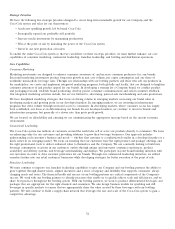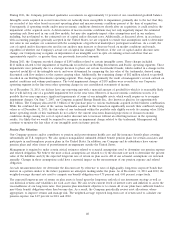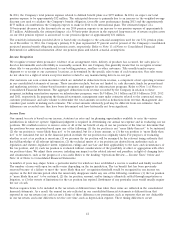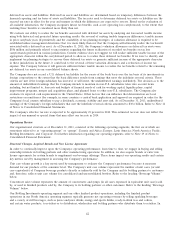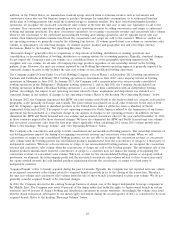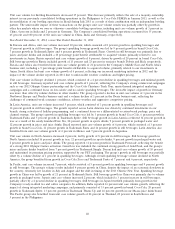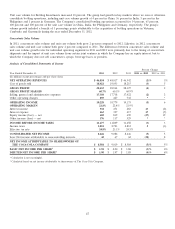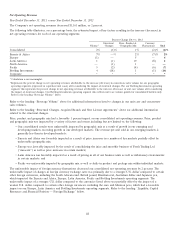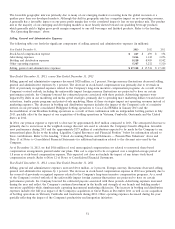Coca Cola 2013 Annual Report Download - page 43
Download and view the complete annual report
Please find page 43 of the 2013 Coca Cola annual report below. You can navigate through the pages in the report by either clicking on the pages listed below, or by using the keyword search tool below to find specific information within the annual report.In 2013, the Company’s total pension expense related to defined benefit plans was $197 million. In 2014, we expect our total
pension expense to be approximately $32 million. The anticipated decrease is primarily due to an increase in the weighted-average
discount rate used to calculate the Company’s benefit obligation, favorable asset performance during 2013 and the approximately
$175 million of contributions the Company expects to make in 2014 to its international plans. The estimated impact of a
50 basis-point decrease in the discount rate on our 2014 pension expense is an increase to our pension expense of approximately
$37 million. Additionally, the estimated impact of a 50 basis-point decrease in the expected long-term rate of return on plan assets
on our 2014 pension expense is an increase to our pension expense of approximately $31 million.
The sensitivity information provided above is based only on changes to the actuarial assumptions used for our U.S. pension plans.
As of December 31, 2013, the Company’s primary U.S. plan represented 57 percent and 63 percent of the Company’s consolidated
projected pension benefit obligation and pension assets, respectively. Refer to Note 13 of Notes to Consolidated Financial
Statements for additional information about our pension plans and related actuarial assumptions.
Revenue Recognition
We recognize revenue when persuasive evidence of an arrangement exists, delivery of products has occurred, the sales price is
fixed or determinable and collectibility is reasonably assured. For our Company, this generally means that we recognize revenue
when title to our products is transferred to our bottling partners, resellers or other customers. Title usually transfers upon
shipment to or receipt at our customers’ locations, as determined by the specific sales terms of each transaction. Our sales terms
do not allow for a right of return except for matters related to any manufacturing defects on our part.
Our customers can earn certain incentives which are included in deductions from revenue, a component of net operating revenues
in our consolidated statements of income. These incentives include, but are not limited to, cash discounts, funds for promotional
and marketing activities, volume-based incentive programs and support for infrastructure programs. Refer to Note 1 of Notes to
Consolidated Financial Statements. The aggregate deductions from revenue recorded by the Company in relation to these
programs, including amortization expense on infrastructure programs, were $6.9 billion, $6.1 billion and $5.8 billion in 2013, 2012
and 2011, respectively. In preparing the financial statements, management must make estimates related to the contractual terms,
customer performance and sales volume to determine the total amounts recorded as deductions from revenue. Management also
considers past results in making such estimates. The actual amounts ultimately paid may be different from our estimates. Such
differences are recorded once they have been determined and have historically not been significant.
Income Taxes
Our annual tax rate is based on our income, statutory tax rates and tax planning opportunities available to us in the various
jurisdictions in which we operate. Significant judgment is required in determining our annual tax expense and in evaluating our tax
positions. We establish reserves to remove some or all of the tax benefit of any of our tax positions at the time we determine that
the positions become uncertain based upon one of the following: (1) the tax position is not ‘‘more likely than not’’ to be sustained,
(2) the tax position is ‘‘more likely than not’’ to be sustained, but for a lesser amount, or (3) the tax position is ‘‘more likely than
not’’ to be sustained, but not in the financial period in which the tax position was originally taken. For purposes of evaluating
whether or not a tax position is uncertain, (1) we presume the tax position will be examined by the relevant taxing authority that
has full knowledge of all relevant information, (2) the technical merits of a tax position are derived from authorities such as
legislation and statutes, legislative intent, regulations, rulings and case law and their applicability to the facts and circumstances of
the tax position, and (3) each tax position is evaluated without considerations of the possibility of offset or aggregation with other
tax positions taken. We adjust these reserves, including any impact on the related interest and penalties, in light of changing facts
and circumstances, such as the progress of a tax audit. Refer to the heading ‘‘Operations Review — Income Taxes’’ below and
Note 14 of Notes to Consolidated Financial Statements.
A number of years may elapse before a particular matter for which we have established a reserve is audited and finally resolved.
The number of years with open tax audits varies depending on the tax jurisdiction. The tax benefit that has been previously
reserved because of a failure to meet the ‘‘more likely than not’’ recognition threshold would be recognized in our income tax
expense in the first interim period when the uncertainty disappears under any one of the following conditions: (1) the tax position
is ‘‘more likely than not’’ to be sustained, (2) the tax position, amount, and/or timing is ultimately settled through negotiation or
litigation, or (3) the statute of limitations for the tax position has expired. Settlement of any particular issue would usually require
the use of cash.
Tax law requires items to be included in the tax return at different times than when these items are reflected in the consolidated
financial statements. As a result, the annual tax rate reflected in our consolidated financial statements is different from that
reported in our tax return (our cash tax rate). Some of these differences are permanent, such as expenses that are not deductible
in our tax return, and some differences reverse over time, such as depreciation expense. These timing differences create
41



